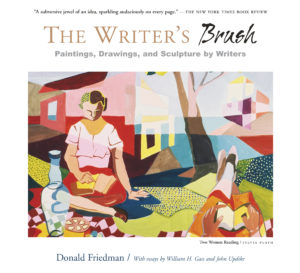How Peter Sacks Joined the Greats
“Paint seems more embedded in the cosmos than language.”
The Poet Picked Up a Paintbrush
You are about to witness a historic moment. A little more than twenty years ago, Peter Sacks, a successful poet and Harvard professor, decided to pick up a paintbrush for the first time. Today, hailed internationally, his work is in the collections of the Metropolitan Museum of Art, the Museum of Modern Art, and Boston’s Museum of Fine Arts among other renowned institutions. In this interview, on the cusp of his transformation, Sacks explained on camera what had led him from text to image, to reframe his creative ideas in a visual expression, and then to move from small to large format. Back then, neither he nor I could have imagined he would join the exalted writer-artists whose visual art equals or exceeds their writing: Arp, Barlach, Blake, Fromentin, Jones, Kokoschka, Lewis, Rossetti, and Strindberg. Yet, looking at the video now, one can see that it’s all there: the talent, the brilliantly articulated vision, the passion bordering on obsession that will carry him through.
Layered Paintings
A Peter Sacks’ painting is fashioned in layers. Besides paint, the layers are comprised of musical scores by Beethoven, Bach, and Mahler, literary and political texts, and whatever materials are at hand, including fabrics and a variety of scrounged items. The layers contain both allusions to world history and to Sacks’ own biography. His visual expressions reflect the sensibility that J.M. Coetzee found in his poetry: “a poet whose sense of history lies deep in his bones…” It is the sensibility that his wife, poet Jorie Graham, described to New Yorker reporter Joshua Rothman, as informed by his life as “the émigré African, the diasporic Jew.” He feels the voices and the music pressing out from behind the canvas.
How Words Became Paint
It was watching a lunar eclipse, says Sacks, that led him out of words and into paint: “As that gradual diminution and then reemergence of light occurred in complete silence, it was as if the materiality of what I was witnessing was more palpable because of the silence.” What he wanted, he said, was “to be there as if I weren’t there.” He realized that “speech is a way of presenting oneself through voice, immediately,” so “by not speaking I think one can entertain the imagining of what it might be like to not be there. So somehow I came back and just started doing the most minute little sequence of sketches of this experience because I wanted to capture duration.”
The Very Small Became Museum-Scale
Although he’d begun with small works, ink drawings and pastels in notebooks and sketchbooks, within a few years he was painting the ravishing, immediately engaging, museum-scale canvases he shows and discusses in this interview. In the process he found that it “was a way to allow parts of my life to get into the work that hadn’t been given the same kind of expression in the poems.”
Sacks was born in 1950 in Port Elizabeth, South Africa. Like his physician father, he planned a medical career but a “mind-opening” visit to racially torn Detroit in the 1960s resulted in his returning home to study political science and philosophy and becoming involved in the antiapartheid movement. He fell in love with poetry while a scholarship student at Princeton. After graduating in 1973, Sacks was a Rhodes Scholar at Oxford. He received his M. Phil. there in 1976 and a Ph.D. from Yale in 1980. A professor of English Literature at Harvard, Sacks is married to poet Jori Graham. His books of poetry include In These Mountains (1986), Promised Lands (1990), Natal Command (1997), O Wheel (2000) and Necessity (2002).
Enjoy the interview and please check out The Writer’s Brush: Paintings, Drawings, and Sculpture by Writers for more than 400 plates of artwork by great writers and the stories behind them.
Connect with me on Twitter, Facebook, Google+, LinkedIn, Medium, YouTube, Goodreads, and please sign up for my blog! You can purchase The Writer’s Brush and other books on Amazon here.
